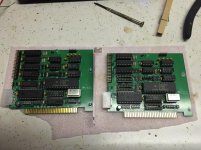SquallStrife
Experienced Member
Edit: Looking more closely at the CF adapter i can see that Pin 28 from the IDE header is connected to Pin 16 (A04) and Pin 14 (A06) of the CF header, Looking at another different CF adapter i can see that Pin 28 from the IDE header to the CF header is NC. So why the 2 address pins are conected to IDE pin 28 i don't know ?
That's even more interesting, as address lines beyond A02 are not used when a CF card is operating in IDE mode. Why would the adaptor designer connect them to /anything/??


